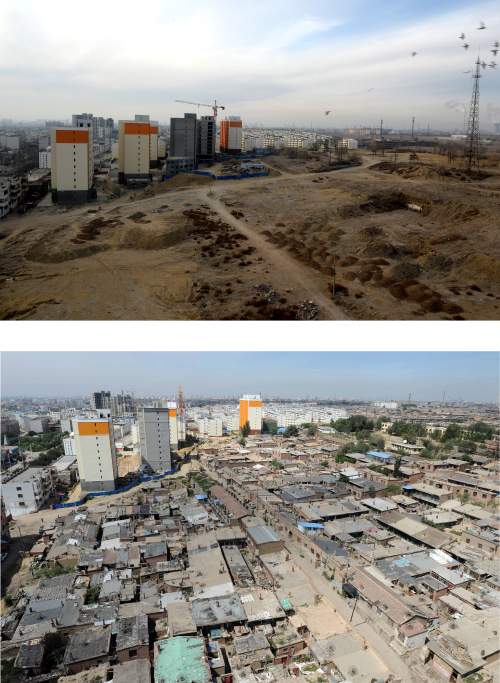|
 |
|
BEFORE AND AFTER: Two pictures show Beiliang Community's transformation. The upper one was taken in January 2015, and the one below was taken in September 2013 (ZHANG LING) |
The couple have no stable income and their first child died from liver disease at the age of 15. Their second child is only 4 years old now. The huge medical expenses have made their financial situation even worse.
Hao's situation is typical in Beiliang. In Donghe District, where Beiliang is located, there are 11,800 registered unemployed people, 70 percent of whom live in Beiliang. "Without the help of the government, there is no way for us to move to a new house," said Hao.
Investment into the renovation project was about 20 billion yuan ($3.23 billion), but the fiscal revenue of Donghe District as a whole is only 1 billion yuan ($161 million) each year.
The money was collected from various resources, including fiscal revenue, bank loans and social donations. After 26 sessions of collective discussion, the city made an operable plan for the whole project.
Yin Zhiqin received about 60,000-yuan ($9,677) compensation from her precious flat house which was less than 20 square meters and subsequently moved into a 50-square-meter low-rent house. "Now we even have some savings," said Yin. "Before this, we couldn't even make ends meet."
The renovated community for Beiliang residents has brand-new houses with a gym and a clinic. "I can play ping-pong in the gym and my wife exercises," said Xie Shiping, a Beiliang resident. "I still can't believe it now. It is like a dream come true."
"Central heating makes winters time cozy," said Wang Xiuquan, over 80. "We used to burn coal in winter, but it was still cold and we had to wear coats and cover ourselves in layers of blankets," said Wang. "Now we can wear T-shirts inside our home."
The nationwide project
China's northeastern provinces, including Liaoning, Jilin and Heilongjiang, started the shantytown renovation project in 2005. More than 2 million residents have since moved into new houses thanks to this project, the largest of its kind since 1949. Other provinces have followed suit.
The Chinese Government has relied heavily on the rebuilding of urban shantytowns to drive domestic demand and improve people's living conditions.
As of 2013, China had provided replacement housing for 2.18 million households from shantytown areas and began projects to address another 3.23 million households--6 percent more than originally planned.
By the end of 2014, China had renovated a total of 20.8 million housing units in the country's urban shantytown areas. In 2014 alone, the target of rebuilding 4.7 million shantytown units has been completed. The government has boosted financial support for renovation work and stepped up construction of supporting facilities.
In 2015, the country plans to start renovating more than 5 million shantytown units, according to the Ministry of Housing and Urban-Rural Development (MOHURD). Chen Zhenggao, former Governor of Liaoning, known for the rebuilding of shantytowns during his term in the northeastern province, was appointed minister of housing and urban-rural development in June 2014.
Chen said China will also continue to push forward with the shantytown renovation program extensively as "it can not only improve people's livelihood but also spur economic growth."
Xiao Wenmei, a 32-year-old resident in Guiyang, capital city of southwest China's Guizhou Province, was still excited as she recalled the moment she received the keys to her new apartment from Premier Li.
Xiao lived with her husband and children in a nearby village, where the roofs of houses leaked and roads became muddy during rainstorms. The local government invested 3 billion yuan ($481 million) in 2009 to build 8,500 apartments for 5,000 households in Xiao's community.
Xiao's family was allotted two apartments, about 300 square meters altogether, as were some other families.
"We'll move into one apartment and rent the other out," she said. "This new home is like a dream for my family."
For Zou Antong, a resident in Tongling, east China's Anhui Province, this Spring Festival is the happiest one he has experienced since he moved out of the shantytown that he had lived for more than 20 years.
Zou, over 60, said he only paid 30,000 yuan ($4,700) for the new apartment in a tall modern building with an elevator. "The place we lived before was humid with almost no sunshine," said Zou. "We didn't have separate kitchen and bathroom before, it's like having a brand-new life."
Email us at: yuanyuan@bjreview.com | 